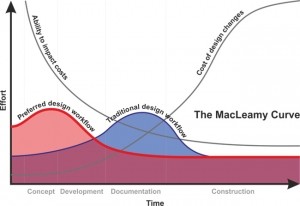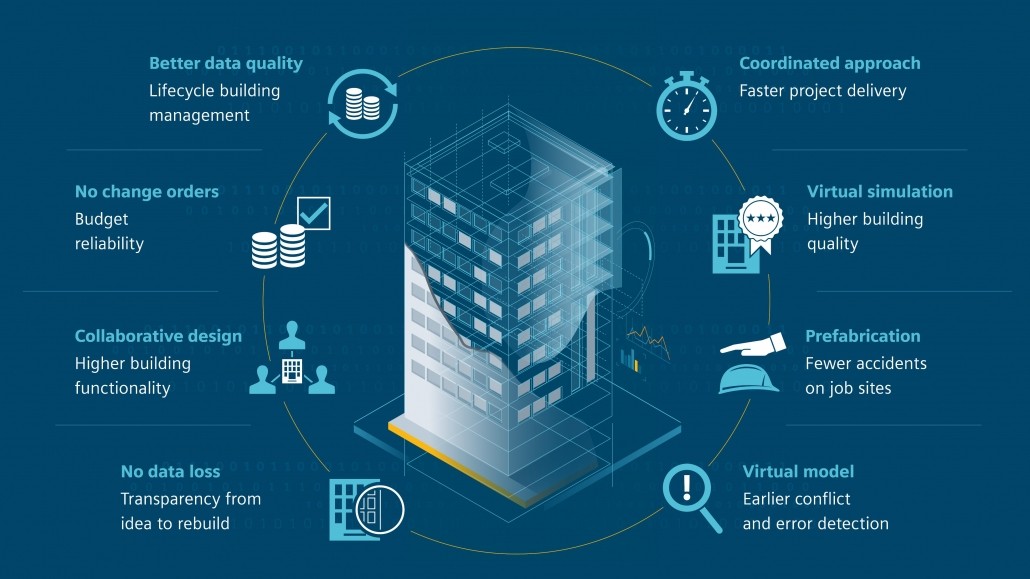New Business Models – BIM (Building Information Modeling) is the Key to the digitalisation of the traditional construction industry
Excerpt from the Bachelor Thesis of Jonas Krauss
Everyone is talking about digitalisation. It changes and presents companies with new challenges. These also reach traditional industries, such as the construction industry. Here, digitalisation is driven primarily by a new methodology, Building Information Modelling (BIM). However, the effects of this cannot yet be fully foreseen. What is certain, however, is that business models can and possibly must also change.
Building Information Modeling – Definition
Almost 35 years have passed since the first works that speak of the idea behind the BIM, and the term itself was already established in 2002 through a white paper from Autodesk. To date, the importance of BIM has continued to grow, and yet a large number of standards and norms are still being developed. Even a generally valid definition of the BIM has not yet been established, which is why three interpretations are given below, which increase in their level of detail.
Against the background of standardising the BIM, the technical committee CEN/TC 422 was founded in May 2015 by the European Committee for Standardisation. The business plan of the committee focuses on the activity of “Standardisation in the field of structured semantic life-cycle information for the built environment”. According to this definition, BIM deals with the management of semantic information that is created during the entire life cycle of an object in the construction industry. Semantic information is equivalent to the information that arises from a detailed description of characteristics with words or characters, for example. With the help of additional attributes, semantic information could be used to store not only 3D models but also other characteristics of an object. Examples are material properties, pressure losses, delivery heads or communication protocols.
Compared to this declaration, the BIM is described in much more detail by DIN SPEC 91400. This standard is not part of the German body of standards and was prepared using the PAS procedure. This means that the standard has been developed in a workshop which can neither guarantee its correctness nor has it involved all stakeholders. Nevertheless, it originates from the cooperation of a number of experts who define BIM as follows: “[BIM is a] method of working in which the spatial component structure is captured in a digital building information model, whereby the spaces and components of the structural and technical installations are described by their characteristic properties and by their relationships to one another.”. In concrete terms, this is a method of working in which information is stored in a digital model. This information describes both the model and the dependencies of model contents on each other.
However, the BIM still does not fully describe this. The German Federal Ministry of Transport and Digital Infrastructure (BMVI) defines BIM in the “Stufenplan Digitales Planen und Bauen” as ” … cooperative working methodology, with which, on the basis of digital models of a building, the information and data relevant to its life cycle are consistently recorded, managed and exchanged in transparent communication between the participants or handed over for further processing. It is particularly clear that BIM is thus a methodology in which “cooperative” work and “communication” are at the forefront.
From these three definitions, BIM can be described as a methodology in which semantic information of a structure is stored digitally. The result is a model that describes the building in detail and records dependencies and relationships between individual contents. This enables the creation of a digital twin of the real object. This can be used for continuous communication throughout all phases of the life cycle of a building and is available to various interested parties. Beginning with the architect and planner and continuing through to the management and demolition of the building, work is carried out jointly on this model. Various authors point out that BIM is often and erroneously understood as a software solution and 3D visualisation only. However, BIM describes a procedure that is supported by software but not based on it. After all, the focus of BIM is primarily on the handling and use of additional semantic information about a component, such as the associated costs and delivery dates, or more precise product specifications. For this reason, instead of talking about new software, we should talk about an evolution of the classic 2D and 3D representation. According to the BMVI, this evolution would offer such great potential that digital models, which accompany all phases in the life cycle of a building, will be indispensable in the future. In the future, a building could be digitally planned, constructed and operated using BIM. This would be made possible by the digital twin, which is created under the motto “first digital, then real building”. Not least for this reason, the publication of the Federal Ministry of Education and Research also refers to the “complete digitalisation” of the construction industry by the BIM.
Background information on the application of BIM in practice
In order to construct modern buildings and meet the challenges of the construction industry, integral planning is often referred to. However, this term also needs to be explained. For example, Heidemann still described integral planning in 2014 as a “mystery” and pointed out that it was often regarded as a “panacea”. It would be desired by planners in order to cope with the increasingly complex requirements in construction projects. However, there is no precise definition of what integral planning is.
Due to the lack of definition, Heidemann represents the goal of integral planning. According to his interpretation, this should ensure the construction of buildings that would meet today’s requirements. To achieve this, it is necessary to consider various factors over the entire life cycle. These include the economic efficiency and necessary flexibility for the intended use of a property, as well as sustainability and safety. Integral planning is thus the approach to take a holistic view of building construction.
From this, the activities in the different phases of the life cycle of a building can be derived. A holistic view from the planning to the demolition of the building is also at the forefront of the BIM methodology. The aim is to control the activities related to and presented in the integral planning in a common model. Coordination work is carried out to structure the processes and thus enable the exchange of planning data between the project participants.
So it seems likely that BIM could actually be the solution to making the mystery of integral design a panacea for complex building projects.
However, this impression is refuted by Liebich, who, on the other hand, makes a different thesis. He is of the opinion that only by using BIM could not all challenges in a construction process be mastered. This is additionally underlined by the authors of Both and Wallner, who point out that BIM only follows the integral approach.
Concluding from the characteristics of the BIM and the comparison with the integral planning, it can be stated that there are great similarities. This is aptly formulated by Treck et al., who describe BIM as an instrument in integral planning methodology.
This instrument is not only suitable for creating a digital model and coordinating cooperation. Instead, the availability of the data also enables the calculation of costs and quantities as well as the adherence to and planning of deadlines. As an example, the calculation of the costs incurred for water pipes could be mentioned here, which can be displayed automatically by the exact determination of the required pipe lengths. In addition, the model is used for collision control or, for example, for structural calculations and for checking whether fire protection regulations have been observed.
However, the decisive factor in determining the options available through BIM is the selection of the dimension up to which information is made available. The higher the dimension, the more information is stored in a BIM model and the more possibilities arise. At present, seven dimensions are usually spoken of, although other dimensions such as building security (8D) are also being considered.

Another indication to specify what level of detail of the data is required is provided by the “Level of Development” (LOD). This is often also referred to as the “Level of Detail” and consists of the LoG (Level of Geometry), LoI (Level of Information), LoC (Level of Coordination) and the LoL (Level of Logistic). For each of the individual levels a definition from 100 (rough) to 500 (fine) is possible. This would make both the geometric indications and the visual presentation and semantic information more specific. As an “as-built” model, the LOD 500 is equivalent to a 7D version of the BIM models. Deviating from the composition of the four different characteristics mentioned above, the LOD is in practice often determined only by the LOG and the LOI. Overall, the decision on which LOD to use depends on the requirements and needs of the construction project. Normally the information content would increase during the project. Just as with the definition of BIM in general or the specification of the information to be transferred, no standards and norms have yet been laid down for this. Due to the many missing standards and norms, many organizations are currently working on the development of these. One of the few standards that has already been established is the IFC standard. This serves the platform-independent transmission of geometric product data and defines a data schema. These features enable the IFC standard to provide an interface. This ensures that the information provided by the parties involved in the common BIM data model can be read and used by others. By using the IFC format as an object-oriented data standard, the individual semantic information could be processed, and relationships and dependencies could be displayed.
However, the definition of the data standard and the LOD alone is not enough to enable cooperation on a construction project. Instead, agreement must also be reached on how the BIM will be used.
A distinction is made between the use of BIM for planning in individual phases (little BIM), or the planning and use of information over the entire life cycle of the project (big BIM). In addition, software solutions from a single manufacturer (closed BIM) or from several manufacturers (open BIM) could be used for this purpose.
If one assumes a continuously used BIM, i.e. a big BIM, there are two possibilities, which should be discussed in more detail at this point.
On the one hand, it is possible to work together on a uniform model using a closed BIM approach and a cloud solution. On the other hand, however, a coordination model used in an open BIM also brings advantages in practice. This allows the use of different software solutions as well as the provision of partial models in an overall coordination model. The digital twin would be gradually filled with the individual models by the individual specialist planners, but not processed in the overall model. For example, not all LODs of the own model would have to be passed on. An actor could consciously choose to provide only selected content. This is also important if the manufacturer does not want to disclose all information about his own product to the customer.
As can already be seen at this point, BIM will create new opportunities, but also activities. For these, the new roles of the BIM Coordinator and the BIM Manager would therefore apply. In Germany, the activities of a BIM coordinator would include activities such as collision control, practical implementation and the organisation of voting. The BIM Manager, on the other hand, advises the client and develops the flow charts at a higher level. This also means that the task of controlling the BIM coordinators falls to him. In addition, he supports all parties involved in the application of BIM. However, these roles, like so much of BIM, have not yet been conclusively defined. This can also be seen in a comparison with other authors who assign other tasks to BIM Coordinators and BIM Managers.
Importance in the construction industry
The construction industry is known as a traditional industry, characterised by inefficiency in its processes and services. This is reflected, among other things, in the fact that productivity is estimated to be low due to outdated processes. In addition, delays and unplanned costs are a daily occurrence and can be attributed to many breaks and a lack of coordination at interfaces. Various information is maintained in individual Excel documents, for example, and costs are determined by combining this information. The BIM methodology, on the other hand, reduces the number of precisely these interfaces to a minimum, simultaneously digitising the processes and controlling communication. BIM thus addresses the root cause of the traditional challenges in the construction industry. For this reason, various authors are also sure that BIM will become established in the long term. Especially since BIM affects the entire life cycle of a building. The BMVI therefore plans to establish BIM as the standard for transport infrastructure projects by 2020. But this does not make the BMVI a pioneer of this new working method. While Germany is still cautious about digitalisation in the construction industry, the Scandinavian countries and Great Britain, for example, are already demanding the use of these working methods.
On a higher level, the BIM promises to make the planning of costs and deadlines in particular more precise and to improve quality. All three aspects should not only be more reliably planned, but also sustainably optimized. It is important to note here that on the one hand the opinion prevails that many of these results will only become apparent in subsequent phases and not in the construction phase itself. On the other hand, however, other authors point out that the advantages are apparent in early phases. This is due to the fact that decisions taken in early phases affect the operating phase of the property. Lifecycle-optimized planning using BIM makes it possible to reduce the costs that arise during the operating phase. Because the use of BIM in the initial phases lays the foundation for how the building will subsequently be operated. In contrast to the operating phase, costs can still be influenced at this point. To achieve these three overall objectives, however, the BIM conceals many other potentials during the planning, construction and the entire life cycle. Due to the large number of positive influences of BIM, only very frequently cited advantages of BIM will be described here as examples.

Since the BIM already starts in the planning phase of the building, visualizes models and enriches them with additional data, the concept can be validated and visualized even before construction begins. This makes it easier for both the architect and the client to plan the object. In addition to promoting cooperation between different trades in a common model, this also accelerates the design process and increases transparency. This prevents different information from being maintained twice and thus avoids potential for errors. This increases the quality of the information. Through this cooperation, dangers can be recognized early and, for example, later collisions during construction can be prevented. Not least of all, this increases the quality of the construction itself.
Due to the BIM’s ability to process semantic information, costs and consumption can be calculated at an early stage. In the course of this it is also possible to optimise them even before the building is in operation. The same advantages result from the data provided in the model for scheduling, logistics and the provision of materials on site.
Since the models also provide information on all systems used in the building, they are also suitable for use when the building is in operation. The integration of the data into a CAFM system and the use of modern technologies creates further advantages. Thus, for example, usage data is available, maintenance can be predicted, and consumption can be controlled.
According to Aranda-Mena et al., the positive effects of BIM mentioned above can be divided into technical and economic, as well as process improvements. This classification once again illustrates the influences of BIM in its comprehensive totality. This also explains why the World Economic Forum calls for BIM to be considered a value driver rather than a cost factor.
A study from 2008 examined 32 projects that were carried out with BIM. This showed that 7% of the project duration could be saved and that the costs defined in advance were 3% closer to the actual costs. In addition, the time required to estimate costs was reduced by 80%, while 40% fewer unplanned changes had to be made. One of the authors of this study, carried out a further investigation of various case studies and calculated an average ROI of 634% without considering the benefits of BIM during the operational phase.
Other sources in turn expect cost savings of ten percent in the long term. In addition, investigations by Lu et al. showed, for example, that BIM ensures that buildings become more environmentally friendly not only during the construction phase, but also during the operating phase.
Overall, a large number of different quantifications with different economic dimensions of BIM can be found. It is therefore highly unlikely that this information is correct for the individual case. Nevertheless, it appears that all developments can be considered positive.
There is also agreement that the BIM shifts efforts in the planning of a building into early phases. This means that over the entire life cycle, less effort is required in the execution phase of construction. In addition, it is even expected that delays due to legal disputes will be eliminated. The BIM makes it easier to trace where errors have occurred and by whom they were caused. Overall, it is therefore assumed that this will minimise liability cases in the long term.
However, with the postponement of expenses, decisions will also be shifted to early phases. This means that future planners could contact suppliers directly. Companies must prepare themselves for this in order to communicate with the right contacts in the right phases. If suppliers do not provide BIM data, they may no longer be considered for the project in question. In contrast, there is a high probability that the early provision of BIM models would ensure that they would be used again in the future.
This would also change business models and could have far-reaching consequences, especially for small and medium-sized companies. The latter would be additionally forced to procure the necessary resources for handling the IT tools of the BIM. In addition, further skills would need to be built up in this area in order to remain competitive. Orders that have been executed by medium-sized companies to date could otherwise shift in favour of the general contractor.

Since BIM is centrally concerned with the handling of information, it is necessary to consider the upcoming development of this in the building life cycle. Thus, the BMVI sees for the future that especially in the operating phase further information will flow into the objects. These would come from systems and devices that already collect and generate data today, or could be additionally connected. This data would then enable concrete statements to be made about all the relevant parameters of an object. Therefore, even textbook authors are confident that the data stored in the BIM model will provide the basis for the commissioning and operation of a building. Especially the interaction with Computer Aided Facility Management (CAFM) systems would play an important role here.
All in all, it can be seen that the BIM already provides a large amount of information that could be used for decisions of all kinds. Often, however, managers lack the software programs needed to actually derive statements from the available information. The future will therefore certainly hold further developments in store.
The points listed here alone should justify the need to address the BIM. This also suggests that the BIM is already used as standard. However, this is not confirmed. Although BIM has been known for a long time, the adaptation rate has fallen far short of expectations. A study by Roland Berger in conjunction with the Fraunhofer Institute shows that BIM is hardly ever used as a planning method. 87% of companies do not use or plan to use BIM even in one of the lowest dimensions, 4D-BIM planning. Similar figures can be found in a report on the current situation in PwC’s construction industry. According to Walasek and Barszcz, the reasons for this were that for a long time no exchange between different software solutions was possible. Furthermore, different user groups had different objectives. Since BIM also changes work processes, adaptation was often very difficult. In addition, new laws and guidelines would have to be drawn up. However, the fact that these challenges did not come as a surprise is confirmed, among others, by Eastman et al. who defined them already in 2008. The lack of standardisation seems to be a major cause and it is therefore considered to be urgently necessary to implement it in order to fully use and implement BIM. Nevertheless, it is clear that the cause also lies in “not wanting to”. This is confirmed by the B_I construction magazine. There it is pointed out that the use of BIM is currently not taking place to the extent that it could, as the boom means that building owners are not interested in testing BIM solutions in parallel with current projects.
This attitude will have to change in the coming years, as the results presented above show: In the future, BIM will be the standard in the construction industry. In response to the BIMMagazin’s questions as to whether BIM will still be discussed in ten years’ time, the experts’ opinions are unanimous. They are sure that BIM will be as standard in the future as CAD is today.
BIM (Building Information Modeling) is a new working methodology using a digital twin of the actual object. This will also be expanded to include information that will simplify and improve cooperation. Thus, the individual models and components contain information about costs and project times, up to information for FM (Facility Management). Although it is apparent that some things have not yet been fully defined, BIM itself is still seen as the future standard for the construction industry.
For this reason, efforts are being made, both at the political level and through other associations, to advance the methodology and establish clear procedures. Because it is also clear that BIM offers a multitude of opportunities and possibilities. Various studies prove the positive influence, especially in terms of time and cost savings, and increased quality. Although BIM is not spreading as quickly as the topic itself suggests, despite these advantages, there is a clear need for companies to take action. They have to deal with the coming changes in order to determine their own potentials and dangers. These appear to be particularly important in terms of relocation of decisions and savings in the operating phase of a property. With BIM, it is certain that digitalisation will also enter the traditional construction industry.
About the author
Jonas Krauss was a DHBW student of industrial engineering at the Friedrichshafen campus until 2018-09. During his time at WALDNER Laboreinrichtungen GmbH & Co KG, Ralf H. KOMOR supervised his Bachelor Thesis entitled: “Development of potential business models based on Building Information Modeling (BIM)”.





